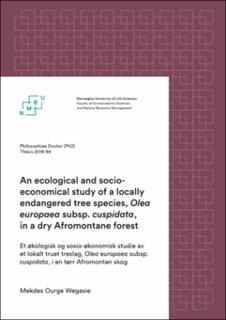| dc.description.abstract | Afromontane forests are found in the tropics and are often threatened because of land use changes. These forests have various types of multipurpose tree species that provide different services to the local communities. However, many of these species are being threatened because of overexploitation, and are therefore, locally endangered. Understanding the relationship between endangered tree species, and biotic, abiotic and human disturbance factors is important to understand their current and future distributions, at both local and larger scales, and to provide good plans for management and conservation. Olea europaea subsp. cuspidata, one of the multipurpose trees in dry Afromontane forests provides vital functions to the local communities. The species is under pressure from overexploitation and considered among the locally endangered tree species in Ethiopia.
This thesis consists of results from studies carried out in a dry Afromontane forest in Northern Ethiopia. The main aim of these studies was to examine which factors influence the performance of a multi-purpose and locally endangered tree species across different levels of organization, i.e. from individual reproductive success, different ontogenetic stages, and abundance on community level. We explored (1) how biotic, abiotic and disturbance factors influence the abundance and biomass of two key dry Afromontane forest species, (2) the population structure and if there are ontogenetic niche shifts in O. europaea in the forest, (3) how the disturbance and environmental factors are related with the reproductive success of O. europaea, (4) the extent of illegal logging of O. europaea in the study area, and what kind of actual benefits the species provide to the local communities. We used vegetation survey, soil samples and questionnaires to sample the data, and generalized linear models and, ordination analyses to analyse the data.
We showed that biotic, abiotic and disturbance factors explained over 40% of the variation in O. europaea abundance and that there was a positive relationship between two endangered species, O. europaea and Juniperus procera and woody species richness, but also an effect of human disturbance. Ontogenetic niche shifts were observed in O. europaea, suggesting that seedlings, saplings, and adults are differently related to woody species richness, soil depth, slope and logging. We also found a negative relationship between the reproductive success of O. europaea and human disturbance. Even if the forest is protected by guards, there is still illegal logging taking place.
With these studies, we concluded that because of the positive relationship between the two tree species and woody species richness, we recommend the forest administrators should consider conserving woody species in general to promote O. europaea and Juniperus procera abundance in degraded areas. For protecting the few O. europaea seedlings in the forest, special attention should be given to protect them from browsing. Moreover, human disturbance is the main factor influencing reproductive success and a reason for illegal logging in the forest. Therefore, we would suggest that allowing the local community to harvest dead wood from the forest might reduce the illegal logging. Finally, we would also suggest establishing permanent plots for monitoring the extent of illegal logging of O. europaea in the forest. | en_US |

